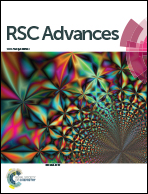Adjusting the photovoltaic performance of big fused ring-based small molecules by tailoring with different modifications†
Abstract
Three novel A–D–A type small-molecule donor materials, namely AAN-DPP2, AAN(T-DPP)2 and AANT(T-DPP)2, with anthanthrene (AAN) as the electron-donating core, diketopyrrolopyrrole (DPP) as the electron-accepting moiety, and thiophene as π-bridge units, have been designed and synthesized for application in bulk-heterojunction (BHJ) organic solar cells (OSCs). Compared to AAN-DPP2, devices based on AAN(T-DPP)2 and AANT(T-DPP)2 show better photovoltaic performance due to broader absorption and better planarity of the molecular backbone. A maximum power conversion efficiency (PCE) of 2.33% with a short-circuit current density (Jsc) of 6.82 mA cm−2 and a fill factor (FF) of 39.80 was obtained in the AAN(T-DPP)2/PC71BM-based solar cells. This is resulting from the suitable thickness of the active layer, improving the ability of catching light and decreasing the twist angle of the backbone by inserting a thiophene spacer. The results indicate that strategic substitution of π-bridges and side-chains in A–D–A type SMs is an efficient strategy to improve photovoltaic performance.



 Please wait while we load your content...
Please wait while we load your content...